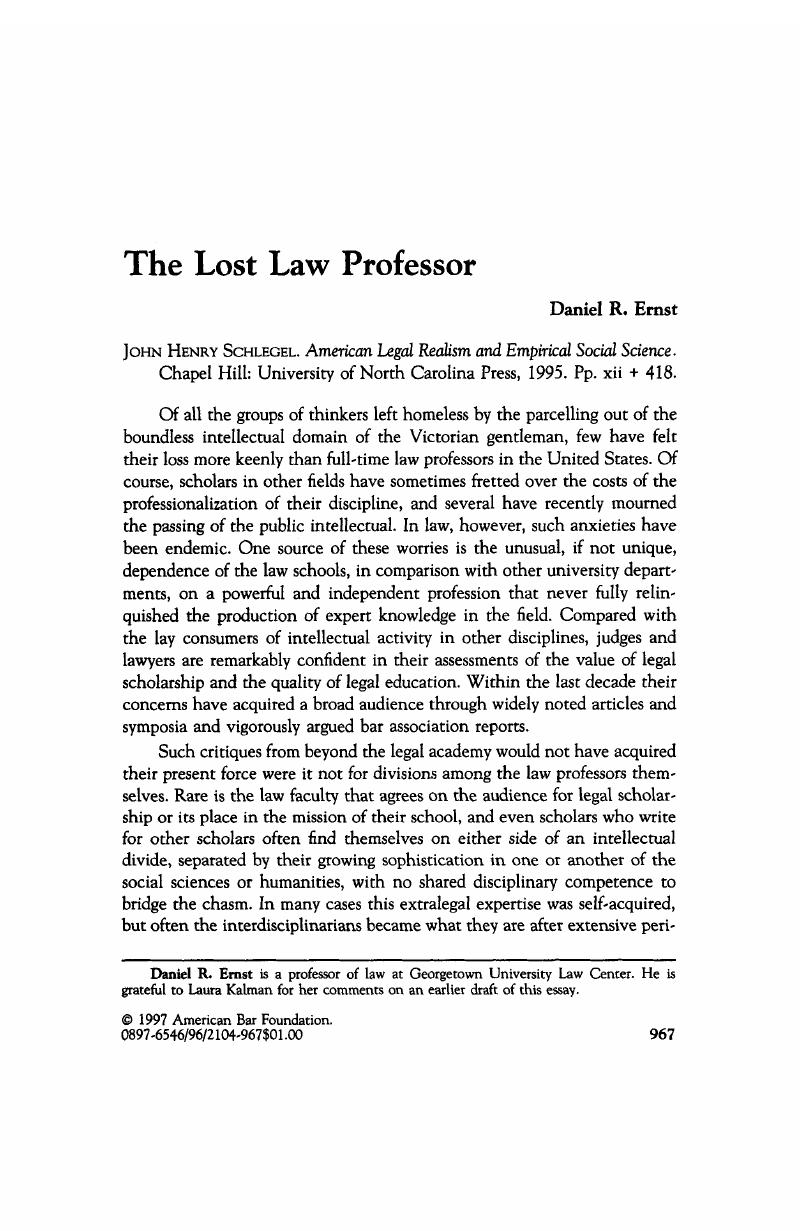No CrossRef data available.
Article contents
The Lost Law Professor
Published online by Cambridge University Press: 27 December 2018
Abstract

- Type
- Review Section Symposium
- Information
- Copyright
- Copyright © American Bar Foundation, 1996
References
1 Edwards, Harry T., “The Growing Disjunction between Legal Education and the Profession: A Postscript,” 91 Mich. L. Rev. 2203–4 (1993).CrossRefGoogle Scholar
2 The other hardships Schlegel inflicts on his readers lack even this justification: frequent and sometimes obscure colloquialisms, jokes that more often distract than inform, and endnoting so wildly excessive that it induces the mental equivalent of whiplash.Google Scholar
3 Schlegel does provide, as a “prologue,” a summary of the conventional wisdom of the rise and fall of Legal Realism. This tends to add to the confusion, however, as it seems to promise a book on Legal Realism as a jurisprudential movement when what follows is a book about how several law professors, commonly known as Legal Realists, fashioned their professional identities. Notwithstanding Schlegel's warning that he has written the latter book, the prologue will encourage readers to think he has written the former. E. g., Herget, James E., review of Schlegel, American Legal Realism and Empirical Social Science, 39 Am. J. Legal Hist. 396 (1995).Google Scholar
4 On Hohfeld, Harvard, and the great Anglo-American debate between the analytical and historical schools, see William Singer, Joseph, “The Legal Rights Debate in Analytical Jurisprudence from Bentham to Hohfeld,” 1982 Wis. L. Rev. 975; William P. LaPiana, Logic and Experience: The Origin of Modern American Legal Education (New York: Oxford University Press, 1994); Alex Frame, Salmond: Southern Jurist 81–82 (Wellington, N. Z.: Victoria University Press, 1995); and Ian Mylchreest, “The Anglo-American Dialogue on Constitutionalism, 1860–1920,” ch. 3. (I am grateful to Dr. Mylchreest, Lecturer in Law at Monash University, for permission to read this manuscript.)Google Scholar
5 Konefsky, Alfred S. & Henry Schlegel, John, “Mirror, Mirror on the Wall: Histories of American Law Schools,” 95 Harvard L. Rev. 833 (1982).Google Scholar
6 For example, the University of Kansas Law School, which gave Moore his first job, figures in Paul Carrington's ongoing discovery and revival of a lost tradition in American legal education. Carrington, Paul D., “Legal Education for the People: Populism and Civic Virtue,” 43 U. Kan. L. Rev. 1 (1994). William Reynolds Vance might have been a good foil, since he was Cook's and Moore's colleague at the University of Wisconsin Law School and Moore's at Yale, where he actively disliked Moore's work. Schlegel dismisses Vance as a “drag” on the Yale Law School (at 360 n.49, 365 n.123).Google Scholar
7 The point of departure for such an account would be Hull, N. E. H., “Restatement and Reform: A New Perspective on the Origins of the American Law Institute,” 1987 Wis. L. Rev. 921 (1987).Google Scholar
8 On the Hohfeldian interlude at the Yale, consult, together with Schlegel's account, Laura Kalman, Legal Realism at Yale, 1927–1960 at 98–101 (Chapel Hill: University of North Carolina Press, 1986) (“Kalman, Legal Realism at Yale”), and Hull, N. E. H., “Vital Schools of Jurisprudence: Roscoe Pound, Wesley Newcomb Hohfeld, and the Promotion of an Academic Jurisprudential Agenda, 1910–1919,” 45 J. Legal Educ. 235 (1995).Google Scholar
9 Henry Schlegel, John, “American Legal Realism and Empirical Social Science: The Singular Case of Underhill Moore,” 29 Buff. L. Rev. 195 (1980).Google Scholar
10 See Camic, Charles & Xie, Yu, “The Statistical Turn in American Social Science: Columbia University, 1890 to 1915,” 59 Am. Soc. Rev. 773 (1994).Google Scholar
11 Schlegel himself writes that Moore identified “his work with that of the practicing lawyer, Holmes's predictor” (at 232). Other critics of Langdellian legal science took the same tack. See Kalman, Legal Realism at Yale 8–9.Google Scholar
12 One issue I wish Schlegel had pursued was the role of gender in the encounter between law and empirical social science at Yale. Schlegel was charmed by Thomas and Corstvet when he interviewed them in 1975. Although he describes them as “real social scientists,” he also shows that they spent much of their careers in the margins of the professionalized academy (at 9). Might not their influence have been limited by the still predominantly masculine nature of the academy?Google Scholar
13 The three are the University of Chicago's Law and Behavioral Science Program, the Walter E. Meyer Research Institute of Law, and the Russell Sage Program. Schlegel explains why he considers the American Bar Foundation “only a modest per contra” to his claim that no one has established a free-standing institute along Cook's lines in a three-sentence foot note (at 374 n.259).Google Scholar
14 As professionally trained economists and members, respectively, of the Columbia and Yale law faculties, Robert Lee Hale and Walton Hale Hamilton might have provided fruitful contrasts with Cook, Moore, and Clark.Google Scholar
15 J. G. A. Pocock, “Comment,” in Eric Ashby, et al., The University on Trial 36 (Christchurch, N. Z.: University of Canterbury, 1973).Google Scholar


